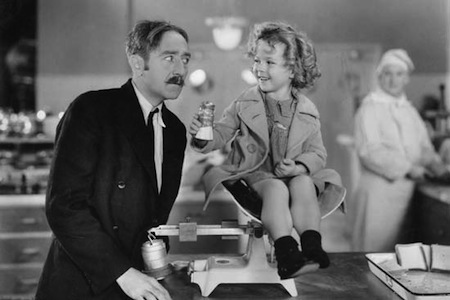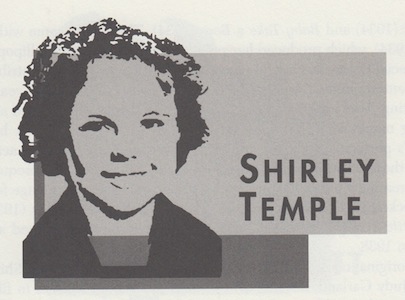Born: April 23, 1928, Santa Monica, CA
I look forward to Shirley someday winning as great a popularity as an actress as she has as a child star.
—Joseph Schenck
While enrolled in dance class at the age of three, Shirley Temple was plucked from a pack of tiny beauties and tested for a new series of kid pictures from the Hal Roach studios called Baby Burlesks. Designed to capitalize on the success of Roach’s Little Rascals, the idea behind the Burlesks series was to have little girls mimic the flirtatious vamps so popular in adult features of the period. Among the talented toddlers, Shirley gave some of the most sophisticated impersonations of modern-day stars.
The charm of the tiny performer emerged over the next few years in a series of supporting roles until Stand Up and Cheer (1934) established her undeniable maturity at age five. She could sing and dance with the best of them, but it was her stunning ability to talk to adults on a deeply emotional level that warmed the hearts of audiences and made her an international star.
She was hailed as the face of prosperity and helped to lift the spirits of a nation following the stock market crash of 1929. Other Depression-era stars like Fred Astaire provided escapism for audiences, but Shirley awakened the hopes for the coming generation. Children loved her movies, adults were astounded by her genuine determination and relentless optimism, and 20th Century Fox was counting its blessings with record hits like Little Miss Marker (1934) and Baby Take a Bow (1934). The height came with Bright Eyes (1934), which produced her popular song “Good Ship Lollipop.”
A special Oscar “in grateful recognition of her outstanding contribution to screen entertainment” was awarded to Shirley in 1934, her first year of feature acting. Toys exploited her charming smile; drinks were named after her and big names like Gary Cooper signed to costar with her. At her best, Shirley’s performances were not simply the standard for child acting but rivaled those of any of the period’s full-grown stars. Each subsequent film was increasingly profitable, and by 1935 she was a star with a huge following that flocked to The Little Colonel (1935), Wee Willie Winkie (1937) and The Little Princess (1939). At the box office, she outperformed all other actors in 1938.
The original choice for Dorothy in The Wizard of Oz (1939), Shirley lost out to Judy Garland. Seeking a new image, she selected roles in films that focused on the problems of teenagers in I’ll Be Seeing You (1944), Since You Went Away (1944), then tried to ease into ingénue parts in The Bachelor and the Bobby-Soxer (1947) and Fort Apache (1948). But her efforts were in vain. As is the fate of many child actors, like Jackie Coogan, her popularity waned as she entered her teens. The audiences that adored her as a child simply didn’t follow her into a new career. Sensing her appeal had forever vanished, she “retired” in a celebrated event held by her studio in 1949.
Already an American institution, she entered Republican Party politics in the late sixties in San Francisco. A bid for a California seat in Congress failed in 1967, but President Gerald R. Ford appointed her U.S. Ambassador to Ghana. In her own lifetime, she has seen her films broadcast weekly on television and her image immortalized in works of art.
Temple’s instant rise and subsequent fall made child actors and their families aware of the questionable longevity of a film career, prompting them to take proper care in investing their profits from early success and to position themselves to ease the transition into adult roles. Among those to benefit from her example were Elizabeth Taylor, Roddy McDowell and Ron Howard, among many others.
To read all the republished articles from ‘The Film 100,’ go to Reintroducing the Film 100 here on Keyframe.





